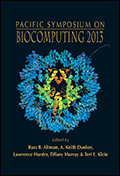Detecting Highly Differentiated Copy-Number Variants from Pooled Population Sequencing
Daniel R. Schrider1, David J. Begun2, Matthew W. Hahn3
1Department of Biology and School of Informatics and Computing, Indiana University;2Department of Evolution and Ecology, University of California;3Department of Biology and School of Informatics and Computing, Indiana University
Email: dschride@indiana.edu
Pacific Symposium on Biocomputing 18:344-355(2013)

Abstract
Copy-number variants (CNVs) represent a functionally and evolutionarily important class of variation. Here we take advantage of the use of pooled sequencing to detect CNVs with large differences in allele frequency between population samples. We present a method for detecting CNVs in pooled population samples using a combination of paired-end sequences and read-depth. Highly differentiated CNVs show large differences in the number of paired-end reads supporting individual alleles and large differences in read- depth between population samples. We complement this approach with one that uses a hidden Markov model to find larger regions differing in read-depth between samples. Using novel pooled sequence data from two populations of Drosophila melanogaster along a latitudinal cline, we demonstrate the utility of our method for identifying CNVs involved in local adaptation.
[Full-Text PDF] [PSB Home Page]